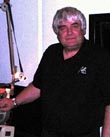|
|
 
|
|
Author
|
Topic: Hearing Aid Loop Systems & SDDS
|
|
|
Joe Redifer
You need a beating today

Posts: 12859
From: Denver, Colorado
Registered: May 99
|
 posted 08-23-1999 04:33 AM
posted 08-23-1999 04:33 AM





Well, I can't help you out on the hearing aid thing, but here are my general opinions on SDDS:First and foremost, most of the units are completely unreliable. This is due to 2 major factors. #1 is the incredibly complex LED arrays which scan the film as it trots by. Unfortunately these have a lifespan of about 1000 or so hours (maybe longer on the new ones.) They don't all burn out at once. Maybe 1 or 2 in each array will go bad. But the SDDS will still try to play, and you will have no clue that any LEDS have gone bad because there isn't any indication on the SDDS unit whether it is cutting to the backup track or cutting in and out successively. But a trip to the auditorium will reveal the problem! Can't miss it! #2 is the fact that the SDDS digital track is located on the outer edges of the film. This part of the film gets the most wear and tear, by leaps and bounds. In fact, during nearly the entire travel of the film, these outer edges are the only thing to come in contact with rollers, coarse gates, traps and intermittent shoes, etc... It quickly deteriorates. Plus the fact that the film labs print the type of film stock every few feet on these edges, and some films (although not too many anymore) have cues printed on the edges that are compatible with Dolby's automation system (anybody know more about this?). None of this can help the SDDS read the data. As far as sound, it seems to me as if they sacrificed some quality for more channels. Have you ever heard the sound quality of a MiniDisc? Well, SDDS is the same exact thing (ATRAC compression) only it is one of the first generations of ATRAC which can sound metallic and hollow. So if you can find one of the first MD recorders around (like the MZ-1) then that is how SDDS sounds, only with 6 channels (up to 8) instead of 2. I can't find any flaws with the way current MiniDiscs sound, but Dolby and DTS both sound noticeably better than SDDS.
| IP: Logged
|
|
AndrewBurnell
Film Handler
Posts: 17
From: Newcastle, NSW, Australia
Registered: Aug 1999
|
 posted 08-23-1999 05:43 AM
posted 08-23-1999 05:43 AM




Thank you for your reply,Does SDDS often use all 8 channels or is it mainly just using 6, to which I see no real advantage over DTS or Dolby Digital! I guess Sony haven't maintained their domestic line reputation with their Cinema Product.
| IP: Logged
|
|
|
|
|
|
|
|
|
|
AndrewBurnell
Film Handler
Posts: 17
From: Newcastle, NSW, Australia
Registered: Aug 1999
|
 posted 08-24-1999 04:05 AM
posted 08-24-1999 04:05 AM




Don't worry, I work for Hoyts!I haven't heard anything through the grapevine about SDDS, I assumed Greater Union would be the ones to use it as they keep up with technology more than Hoyts. Brad: I dont know how it works but we have an extra amplifier with runs some kind of cable around the interior of the cinema (hidden of course) and this must make it easier for the hearing aids to get signal <shrug>! I don't know what brand of amp it is, all our amps have Hoytech printed on the front (how inventive). Another thing I found weird was that all our screen speakers are JBL, and all our surround speakers are Krix! Didn't think acoustics would match. As far as your screenvision conversation went. We just play a selection of slides at the start of each movie (usually 5-10, only 30secs each) accompanied by tape, we then play usually 3-4 previews and into the feature it goes.
| IP: Logged
|
|
|
|
Steffan Laugharne
Film Handler

Posts: 15
From: Biggleswade, Beds, UK
Registered: Apr 2001
|
 posted 05-22-2001 03:26 PM
posted 05-22-2001 03:26 PM




I've been trawling through the archives, being new to the group and no one has replied to the original question: how does a Hearin Impaired loop work. Well here goes.The a.c. current of an audio signal passing through a wire will create an elctromagnetic field that radiates out from the wire. When two wires are in close proximity to each other, the electromagnetic field of one will induce a current in the other. The loop running around the theatre forms one 'wire' and the second 'wire' is the so called T-coil in the deaf persons hearing aid. Thus the signal from the induction loop driver is picked up by the hearing aid. Of course the stength of 'pick up'or induction varies with distance. This will explain why badly positioned induction loops will cause cross talk between adjacent theatres in a multiplex. All the best Steff
| IP: Logged
|
|
Randy Stankey
Film God

Posts: 6539
From: Erie, Pennsylvania
Registered: Jun 99
|
 posted 05-22-2001 10:22 PM
posted 05-22-2001 10:22 PM




If you have a SDDS that seems to be misbehaving on you there is one way to get an indication of how well it's reading but it is rather rudimentary:Open the door of the decoder and look inside, on the left side of the lower PC board. There is a row of surface mount LEDs. Take a look at the second and third LEDs from the left. The second LED indicates that the system is getting a "lock" on the "P-Track". (Picture-Side, or inboard track.) The third one indicates that they system is getting a lock on the "S-Track". (Soundtrack-Side, or outboard track.) If one of these LEDs is flickering or goes out completely you are losing (or have lost) the data from that track. At this point you can still get the "backup" data from the other track but it will probably sound really crummy. If both of the LEDs go out then you have lost SDDS sound entirely. The player will kick out of digital. Okay... So this amounts to nothing more than an "idiot light". It's like the oil pressure light on your car's instrument panel that basically tells you that your engine just blew up. At least when people keep calling you up and saying, "The sound is all messed up.", you have something to verify the unit's operation. (Or lack thereof.) One thing I would like is to make the processor defalut back to analogue and stay there after a certain number of times.
| IP: Logged
|
|
|
|
All times are Central (GMT -6:00)
|
|
Powered by Infopop Corporation
UBB.classicTM
6.3.1.2
The Film-Tech Forums are designed for various members related to the cinema industry to express their opinions, viewpoints and testimonials on various products, services and events based upon speculation, personal knowledge and factual information through use, therefore all views represented here allow no liability upon the publishers of this web site and the owners of said views assume no liability for any ill will resulting from these postings. The posts made here are for educational as well as entertainment purposes and as such anyone viewing this portion of the website must accept these views as statements of the author of that opinion
and agrees to release the authors from any and all liability.
|

 Home
Home
 Products
Products
 Store
Store
 Forum
Forum
 Warehouse
Warehouse
 Contact Us
Contact Us




 Printer-friendly view of this topic
Printer-friendly view of this topic















